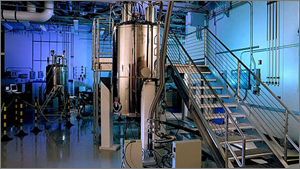Lessons from EM Purcell
by
 Sundays represent many things to many people. For chemists, this Sunday marks the birthday of physicist E.M. Purcell, discoverer of nuclear magnetic resonance (NMR). Born on August 30, 1912, Purcell discovered NMR in 1945 and shared the Nobel Prize in 1952 with Felix Bloch, who independently discovered it one month after Purcell.
Sundays represent many things to many people. For chemists, this Sunday marks the birthday of physicist E.M. Purcell, discoverer of nuclear magnetic resonance (NMR). Born on August 30, 1912, Purcell discovered NMR in 1945 and shared the Nobel Prize in 1952 with Felix Bloch, who independently discovered it one month after Purcell.
For chemists, it’s hard to imagine a world without NMR. It can be used to determine structure, analyze purity and monitor reaction progress. Beyond chemistry, NMR is more commonly known to the public through it’s application in magnetic resonance imaging (MRI) for medical diagnosis and clinical studies.
During World War II, Purcell worked on a wartime radar development project at the MIT Radiation Lab. As various radar advancements were developed, Purcell and his colleagues would test them by observing various buildings in the Boston area from the radar mounted atop an MIT building. It was during a seemingly routine decrease in the radar wavelength that Purcell observed a paradoxical reduction in radar sensitivity. Despite the anticipated strength of the new radar, the researchers were unable to observe even the closest buildings. The experiment was deemed a catastrophic failure.
It turned out that by chance, the energy of the electromagnetic wave matched the transition between two rotational energy states of water in the atmosphere. As a result, the radar signal was absorbed by atmospheric water, completely destroying the radar wave. More importantly, the discovery that water absorbed electromagnetic waves only at a very specific energy forced Purcell to consider that atoms had excited and relaxed states (the two-state model).
Although radar and NMR are fundamentally different, the concept of two-state systems provided the theoretical foundation for Purcell’s NMR hypothesis.
So this Sunday take a minute to stop and tip your hat to E.M. Purcell. As we move through our own careers and projects, it’s important to realize that inspiration may come in any form at any time. Remember that your next failed experiment may bring you one step closer to a truly revolutionary breakthrough.
For a more detailed description of Purcell’s work and discoveries, see:
M. Gerstein, Purcell’s Early Work on NMR: Contingency vs. Inevitability, Am. J. Physics 62:596-601.


leslie
wrote on August 29, 2009 at 12:19 am
I CANNOT WAIT to pull this piece of trivia out to my know it all friends (and I have many)…thank you Alan!!
alan@benchfly
wrote on August 31, 2009 at 4:05 am
Let 'em have it!
dayman
wrote on August 31, 2009 at 9:59 pm
Great story, but seriously though, how pissed must Bloch have been when he had everything all done and then sees he got scooped?? All's well that ends well, with him getting recognized for it, but I can only imagine the nervous breakdown that must have occurred.